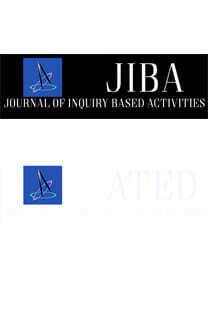HOW AND WHY DOES THE MULTIPLICATION METHOD DEVELOPED BY THE RUSSIAN PEASANTS WORK?
RUS KÖYLÜLERİN GELİŞTİRDİĞİ ÇARPMA YÖNTEMİ NASIL VE NEDEN ÇALIŞIYOR?
___
Atasoy, E., & Atasoy, Ş. (2006). Farklı yazma etkinliklerinin 6. Sınıf öğrencilerinin düşünceleri ve davranışları üzerindeki etkilerinin belirlenmesi [Determination of the effects of different writing activities on students’ thinking and behaviors of Grade 6 students]. Hasan Ali Yücel Eğitim Fakültesi Dergisi, 3(1), 1-18.Birgin, O., & Gürbüz, R. (2009). İlköğretim II. kademe öğrencilerinin rasyonel sayılar konusundaki işlemsel ve kavramsal bilgi düzeylerinin incelenmesi [Examining the primary school stage II students’ level of procedural and conceptual knowledge of rational numbers]. Uludağ Üniversitesi Eğitim Fakültesi Dergisi, 22(2), 529-550
Burns, M. (2004). Writing in math. Educational Leadership, 62(2), 30-33.
Kilpatrick, J., Swafford, J., & Findell, B. (Eds.). (2001). Adding it up: Helping children learn mathematics. Washington, D.C.: National Academy Press.
Lee, J. E. (2014). Deciphering with the area model multiplication algorithms. Mathematics Teaching in the Middle School, 19(9), 556-563.
Lin, C. Y. (2007). Teaching multiplication algorithms from other cultures. Mathematics Teaching in the Middle School, 13(5), 298-304.
Ministry of National Education. (2005). İlköğretim matematik dersi 6-8. Sınıflar öğretim program ve kılavuzu [Foundational education 6-8 grades mathematics curriculum and guide]. Ankara: Talim ve Terbiye Kurulu Başkanlığı.
Ministry of National Education. (2017). Matematik dersi öğretim programı (İlkokul ve ortaokul 1, 2, 3, 4, 5, 6, 7 ve 8. sınıflar) [Mathematics curriculum Elementary and middle school 1, 2, 3, 4, 5, 6, 7, and 8th grades)]. Retrieved from http://mufredat.meb.gov.tr/ProgramDetay.aspx?PID=329
National Council of Teachers of Mathematics. (2000). Principles and standards for school mathematics. Reston, VA: Author
National Council of Teachers of Mathematics. (2014). Principles to actions: Ensuring mathematics success for all. Reston, VA: Author.
National Governors Association Center for Best Practices, Council of Chief State School Officers (2010). Common core state standards for mathematics. Retrieved from http://www.corestandards.org/assets/CCSSI_Math%20Standards.pdf
Olkun, S., & Uçar, Z. T. (2009). İlköğretimde etkinlik temelli matematik öğretimi [Activity-based mathematics teaching in foundational education]. Ankara: Maya Akademi Eğitim ve Danışmanlık
Seo, B. (2015). Mathematical writing: What is it and how do we teach it? Journal of Humanistic Mathematics, 5(2), 133-145. doi: 10.5642/jhummath.201502.12
Van de Walle, J. A., Karp, K. S., & Bay-Williams, J. W. (2013). İlkokul ve ortaokul matematiği: Gelişimsel yaklaşımla öğretim [Elementary and middle school mathematics: Teaching developmentally] (7. baskıdan çeviri).(S. Durmuş, Çev. [Trans.]). Ankara: Nobel Yayınları
Yılmaz, N. (2015). Cebir öğretiminde yazma etkinliklerini kullanmanın ortaokul 7. sınıf öğrencilerinin başarılarına etkisi [The impact of using writing activities in teaching algebra on secondary school seventh grade students’ achievements]. Abant İzzet Baysal Üniversitesi Eğitim Fakültesi Dergisi, 15(1), 357-376.
- ISSN: 2146-5711
- Yayın Aralığı: 2
- Başlangıç: 2011
- Yayıncı: Mustafa ÇAKIR
LEARNING MATHEMATICS WITH CREATIVE DRAMA
RUS KÖYLÜLERİN GELİŞTİRDİĞİ ÇARPMA YÖNTEMİ NASIL VE NEDEN ÇALIŞIYOR?
PREPARING DATA REPRESENTATION ACTIVITIES FOR YOUNG LEARNERS
HOW AND WHY DOES THE MULTIPLICATION METHOD DEVELOPED BY THE RUSSIAN PEASANTS WORK?
KÜÇÜK ÇOCUKLAR İÇİN VERİ GÖSTERİMİNE YÖNELİK AKTİVİTELER HAZIRLAMA
YARATICI DRAMA İLE MATEMATİK ÖĞRENİYORUM
MATHEMATICAL MODELING ACTIVITY: MURAT’S MOBILE PHONE
BURÇAK BOZ YAMAN, Melike UYARLI
